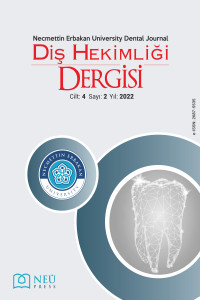Pulpal-Periapikal Patolojiler ile Hemofili Arasındaki İlişkinin İncelenmesi
Amaç:Diş hekimleri hastalarının genel sağlık durumlarıyla ilgili oluşan pek çok değişikliğin içerisinde olan sağlık çalışanlarıdır. Bu çalışmanın amacı, pulpal-periapikal patoloji ve hemofili hastalığının olası ilişkisini araştırmaktır. Gereç ve Yöntemler: Kliniğimize başvurmuş olan, sistemik olarak Hemofili A ve Hemofili B hastalığı dışında başka bir hastalığı olmayan, teşhis amaçlı panoramik ve/veya periapikal radyografı alınmış olan, 4-16 yaş arasındaki bireylerin ağız içi muayeneleri yapılarak çürüklü, çekilmiş ve dolgulu diş sayıları ile periodontal ve gingival indeksleri kaydedilmiştir. Çalışma kapsamında istatistik analizler için IBM SPSS Statistics (Versiyon 26.0. Armonk, NY: IBM Corp.) istatistik programından yararlanılmıştır. Kategorik veriler, sayı ve yüzde olarak ifade edilmiş, açık uçlu veriler ortalama ve standart sapma olarak ifade edilmiştir. Yapılan ölçümlere ilişkin karşılaştırmalı değerlendirmelerde ki-kare ve bağımsız örneklem t testinden yararlanılmıştır. Anlamlılık düzeyi p<0,05 olarak kabul edilmiştir. Bulgular: Araştırmada katılımcıların %24’ü kız, % 76’sı erkek hastalardan oluşmaktadır. Sistemik hastalık varlığı bakımından incelendiğinde; katılımcıların %49,6’sı hemofiliye sahipken, %50,4’ü sağlıklıdır. Sağlıklı ve hemofili grup arasında cinsiyetleri bakımından anlamlı bir farklılık bulunmamaktadır (p>0,05). Katılımcıların sistemik hastalık durumlarına göre yaşları bakımından istatistiksel olarak anlamlı bir farklılık bulunmamaktadır (p>0,05). Pulpal periapikal lezyon ile sistemik hastalık arasındaki ilişkiyi belirlemek üzere ki kare analizi gerçekleştirilmiştir. Elde edilen sonuçlara göre; hemofili katılımcıların %47,7’sinde pulpal periapikal lezyon bulunurken, sağlıklı katılımcıların ise %24,6’sında periapikal lezyona rastlanmıştır. Katılımcıların pulpal periapikal lezyon ve sistemik hastalık varlıkları arasında istatistiksel olarak anlamlı bir ilişki bulunmaktadır (p<0,05). Sonuç: Çalışmamız, sistemik hastalıkların periapikal enflamasyon üzerindeki etkilerininin bütüncül bir yaklaşımla incelenmesinin önemini vurgulamaktadır. Bu alanda sistemik hastalıklar ve pulpal-periapikal lezyonlar arasındaki bağlantı araştırılmaya devam edilmelidir. Anahtar Kelimeler: Hemofili 1, Periapikal patoloji 2, Diş çürüğü 3, ABSTRACT Aim: Dentists are health workers who are involved in many changes related to the general health status of their patients. The aim of this study is to investigate the possible relationship between pulpal-periapical pathology and hemophilia. Materials and Methods: Intraoral examinations of individuals aged 4-16 years who applied to our clinic, who do not have any other systemic disease other than Hemophilia A and Hemophilia B disease, who had panoramic and/or periapical radiographs for diagnostic purposes, were examined, and the number of decayed, extracted and filled teeth, periodontal and gingival indexes are recorded. Within the scope of the study, IBM SPSS Statistics (Version 26.0. Armonk, NY: IBM Corp.) statistical program was used for statistical analysis. Categorical data were expressed as numbers and percentages, and open-ended data were expressed as mean and standard deviation. Chi-square and independent sample t-test were used in the comparative evaluations of the measurements. Significance level was accepted as p<0.05. Results : In the study, 24% of the participants consisted of female patients and 76% male patients. When examined in terms of the presence of systemic disease; 49.6% of the participants had hemophilia, while 50.4% were healthy. There was no significant difference between the healthy and hemophiliac groups in terms of gender (p>0.05). There was no statistically significant difference in age of the participants according to their systemic disease status (p>0.05). Chi-square analysis was performed to determine the relationship between pulpal periapical lesion and systemic disease. According to the results obtained; While pulpal periapical lesion was found in 47.7% of hemophilia participants, periapical lesion was found in 24.6% of healthy participants. There was a statistically significant relationship between the presence of pulpal periapical lesion and systemic disease of the participants (p<0.05). Conclusion: Our study highlights the importance of examining the effects of systemic diseases on periapical inflammation with a holistic approach. The link between systemic diseases and pulpal-periapical lesions should continue to be investigated in this area.
Anahtar Kelimeler:
hemofili, periapikal patoloji, diş çürüğü
___
- 1. Gupta A, Aggarwal V, Mehta N, Abraham D, Singh A. Diabetes mellitus and the healing of periapical lesions in root filled teeth: A systematic review and meta-analysis. Int. Endod. J. 2020; 53: 1472–4.
- 2. Cavalla F, Letra A, Silva R, Garlet G. Determinants of Periodontal/Periapical Lesion Stability and Progression. J. Dent. Res. 2021; 100: 29–36.
- 3. Zero D, Zandona A, Vail M, Spolnik K. Dental caries and pulpal disease. Dent. Clin. N. Am. 2011; 55: 29–46.
- 4. Georgiou, A Crielaard W, Armeni I, Vries R, van der Waal S. Apical Periodontitis Is Associated with Elevated Concentrations of Inflammatory Mediators in Peripheral Blood: A Systematic Review and Meta-analysis. J. Endod. 2019: 45: 1279–95.
- 5. Poyato-Borrego M, Segura-Sampedro, Martin-Gonzalez J, Torres-Dominguez Y, Velasco-Ortega E, Segura-Egea J. High Prevalence of Apical Periodontitis in Patients With Inflammatory Bowel Disease: An Age- and Gender-matched Case-control Study. Inflamm. Bowel Dis. 2020; 26: 273–9
- 6. Frisk F, Hakeberg M, Ahlqwist M, Bengtsson C. Endo-dontic variables and coronary heart disease. Acta Odontol Scand 2003; 61:257-262.
- 7. Leonardi Dutra K, Haas L, Porporatti A, Flores-Mir C, Nascimento Santos J, Mezzomo LA, Correa M, De Luca Canto G. Diagnostic Accuracy of Cone-beam Computed Tomography and Conventional Radiography on Apical Periodontitis: A Systematic Review and Meta-analysis. J. Endod. 2016; 42: 356–364.
- 8. Segura-Egea J, Martín-González J, Cabanillas-Balsera D, Fouad A, Velasco-Ortega E, López-López J. Association between diabetes and the prevalence of radiolucent periapical lesions in root-filled teeth: Systematic review and meta-analysis. Clin. Oral Investig. 2016; 20: 1133–1141.
- 9. Jalali, P, Glickman G, Schneiderman E.D, Schweitzer L. Prevalence of Periapical Rarefying Osteitis in Patients with Rheumatoid Arthritis. J. Endod. 2017; 43: 1093–1096.
- 10. Bui F, Almeida-da-Silva C.L.C, Huynh B, Trinh A, Liu J, Woodward J, Asadi H, Ojcius DM. Association between periodontal pathogens and systemic disease. Biomed. J. 2019; 42: 27-35.
- Yayın Aralığı: Yılda 3 Sayı
- Başlangıç: 2019
- Yayıncı: Necmettin Erbakan Üniversitesi
Sayıdaki Diğer Makaleler
Zeynep TAŞTAN EROĞLU, Dilek ÖZKAN ŞEN, Fatma UCAN YARKAC, Fatma SARAÇ
Pulpal-Periapikal Patolojiler ile Hemofili Arasındaki İlişkinin İncelenmesi
Yasemin Derya FİDANCIOĞLU, Hazal ÖZER, Ayşe ŞİMŞEK, Hüseyin TOKGÖZ
Nuran YANIKOĞLU, Özcan AKKAL, Gülsüm AKKAYA
Diş Hekimliği Fakültesine Başvuran Hastaların Dental İmplant Farkındalıkların Değerlendirilmesi
Dilek ÖZKAN ŞEN, Fatma UCAN YARKAC, Zeynep TAŞTAN EROĞLU, Hilal Gülcan SEYFİOĞLU
Subpontik Osseöz Hiperplazi: Bir Retrospektif Çalışma
İbrahim Burak YÜKSEL, Neslihan GÜNTEKİN, Ali ALTINDAĞ, Ali Riza TUNCDEMİR
